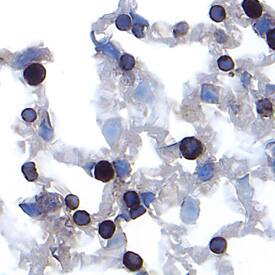Mouse Cathepsin E Antibody
R&D Systems, part of Bio-Techne | Catalog # AF1130


Key Product Details
Species Reactivity
Validated:
Cited:
Applications
Validated:
Cited:
Label
Antibody Source
Product Specifications
Immunogen
Gln19-Pro397
Accession # P70269
Specificity
Clonality
Host
Isotype
Scientific Data Images for Mouse Cathepsin E Antibody
Cathepsin E in Mouse Lung.
Cathepsin E was detected in perfusion fixed frozen sections of mouse lung using Goat Anti-Mouse Cathepsin E Antigen Affinity-purified Polyclonal Antibody (Catalog # AF1130) at 15 µg/mL overnight at 4 °C. Tissue was stained using the Anti-Goat HRP-DAB Cell & Tissue Staining Kit (brown; Catalog # CTS008) and counterstained with hematoxylin (blue). Specific labeling was localized to the plasma membrane of type II alveolar cells. View our protocol for Chromogenic IHC Staining of Frozen Tissue Sections.Applications for Mouse Cathepsin E Antibody
Immunohistochemistry
Sample: Perfusion fixed frozen sections of mouse lung
Immunoprecipitation
Sample: Conditioned cell culture medium spiked with Recombinant Mouse Cathepsin E (Catalog # 1130-AS), see our available Western blot detection antibodies
Western Blot
Sample: Recombinant Mouse Cathepsin E (Catalog # 1130-AS)
Reviewed Applications
Read 1 review rated 5 using AF1130 in the following applications:
Formulation, Preparation, and Storage
Purification
Reconstitution
Formulation
Shipping
Stability & Storage
- 12 months from date of receipt, -20 to -70 °C as supplied.
- 1 month, 2 to 8 °C under sterile conditions after reconstitution.
- 6 months, -20 to -70 °C under sterile conditions after reconstitution.
Background: Cathepsin E
Cathepsin E is an intracellular aspartic protease of the pepsin family (1, 2). Unlike Cathepsin D, another member of the same family and a lysosomal protease with relatively ubiquitous distribution, Cathepsin E is not a lysosomal enzyme and has a limited cell and tissue distribution. However, both Cathepsins D and E play an important role in the degradation of proteins, the generation of bioactive proteins, and antigen processing (3). Both enzymes are efficient in cleaving the Swedish mutant of amyloid precursor protein (APP) at the beta site but show almost no reactivity with the wild-type APP (4). Mouse Cathepsin E is synthesized as a precursor protein, consisting of a signal peptide (residues 1-18), a propeptide (residues 19-59), and a mature chain (residues 60-397) (1).
References
- Tatnell, P.J. et al. (1997) FEBS Lett. 408:62.
- Kay, J. and P.J. Tatnell (2004) in Handbook of Proteolytic Enzymes (Barrett, A.J. et al., eds.), p. 33, Academic Press, San Diego.
- Tsukuba, T. et al. (2000) Mol. Cells 10:601.
- Gruninger-Leitch, F. et al. (2000) Nat. Biotechnol. 18:66.
Alternate Names
Gene Symbol
UniProt
Additional Cathepsin E Products
Product Documents for Mouse Cathepsin E Antibody
Product Specific Notices for Mouse Cathepsin E Antibody
For research use only